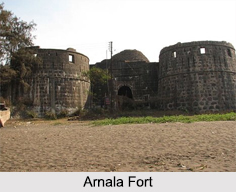 Being an island fort, the Arnala Fort is also known by the names of Janjire Arnala and Jaldurg. The fort is built on the small island of the port town of Arnala in the state of Maharashtra. The structure was renovated and strengthened by the Portuguese during their rule on Arnala Fort. During that era, it was renamed as Ilha Das Vacas.
Being an island fort, the Arnala Fort is also known by the names of Janjire Arnala and Jaldurg. The fort is built on the small island of the port town of Arnala in the state of Maharashtra. The structure was renovated and strengthened by the Portuguese during their rule on Arnala Fort. During that era, it was renamed as Ilha Das Vacas.
History of Arnala Fort
The Arnala Fort was originally built in 1516 by Sultan Mahmud Begda, who was a local chieftain from Gujarat. The fortress was strategically erected at the mouth of the Vaitarna River on the island. The Portuguese gained dominance on the small island after they based their operations in the coastal area headquartered at Bassein Fort in the 1530s. A Portuguese nobleman demolished the old fortress and built a new fort in the site. However, the nobleman was unable to complete the construction work. The structure was occupied by the Portuguese for the next two centuries. It was mainly utilized for navigation along the northern Konkan coast and to control shipping.
In the 18th century, the Maratha Empire took control of Maharashtra and Chimaji Appa, the brother of Peshwa Baji Rao I, took control of Bassein Fort from the Portuguese in 1737. After gaining victory in the Battle of Vasai, Chimaji attacked Fort Arnala as the site was strategically significant for the naval forces of the Maratha Empire. The initial assault of the Marathas on the fortress was co-ordinated with the Maratha naval force. But it was expelled by a stronger Portuguese naval force. The second attack on the fort was conducted in March 1737. This time the Portuguese forces were defeated by the Maratha army and the Arnala Fort came under the possession of the Maratha Empire.
The Arnala Fort remained under the control of the Marathas till the year 1817. However, after the Third Anglo Maratha War, the Marathas were compelled to surrender the fortress to the superior naval force of the British East India Company.
But after the treaty of Salabai, the forts of Bassien and Arnala were given back to the Maratha Empire by the British administration in India. These were again returned to the British under the treaty of Pune.
Design of Arnala Fort
Under the reign of the Marathas, the entire structure of the Arnala Fort was renovated and rebuilt. Construction of three bastions, namely Bava, Bhavani and Bahirav were done. The main gateway of the fort is faced towards the northern direction. The entrance is built with solid stone and is decorated with images of various animals like elephants and tigers. The outer ramparts and walls of the fort were strongly fortified in order to protect the inner parts of the fort. Moreover, they are 3 m wide along the exterior walls.
Other than these, there is a watch tower located towards the south of the island and almost 550 m away from the main structure. There is no direct entrance into the tower. The Arnala Fort also consists of a vast octagonal reservoir that stores and supplies fresh water. Apart from these, there are several temples inside the premise of the fortress, like the temples of Lord Shiva, Goddess Bhavani and Ambakeshwar. The site also has the tombs of Hajjali and Shahali.
Present Condition of Arnala Fort
Currently, the Arnala Fort lies in a state of disrepair. The property is presently owned by the Government of India. The site is now open to visitors and tourists who visit the fort throughout the year.
Visiting Information on Arnala Fort
The nearest railway station is at Virar at a distance of about 9 km from the fort and the Chhatrapati Shivaji International Airport in Mumbai is the closest airport at a distance of almost 66 km from the Arnala Fort.



















